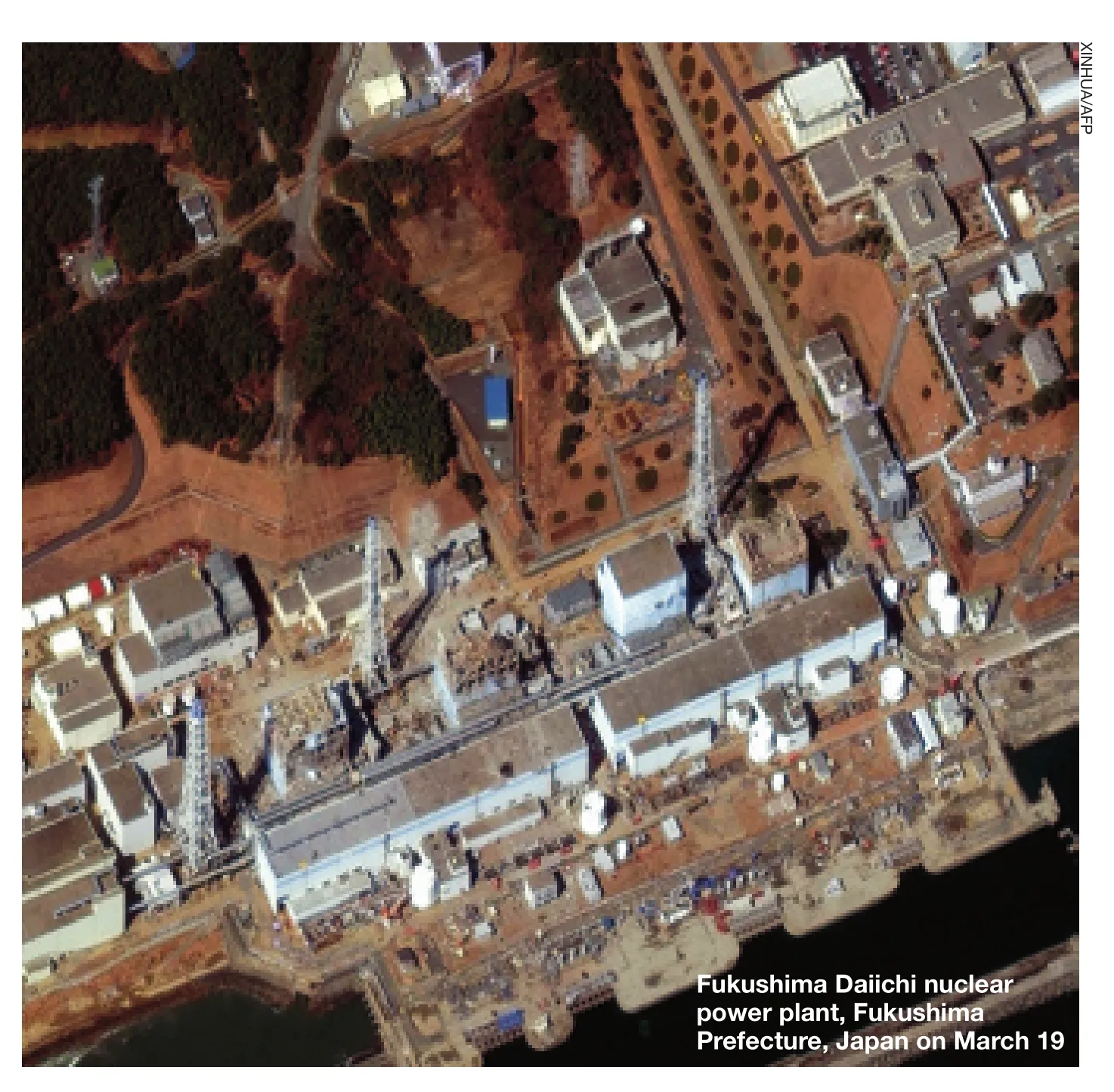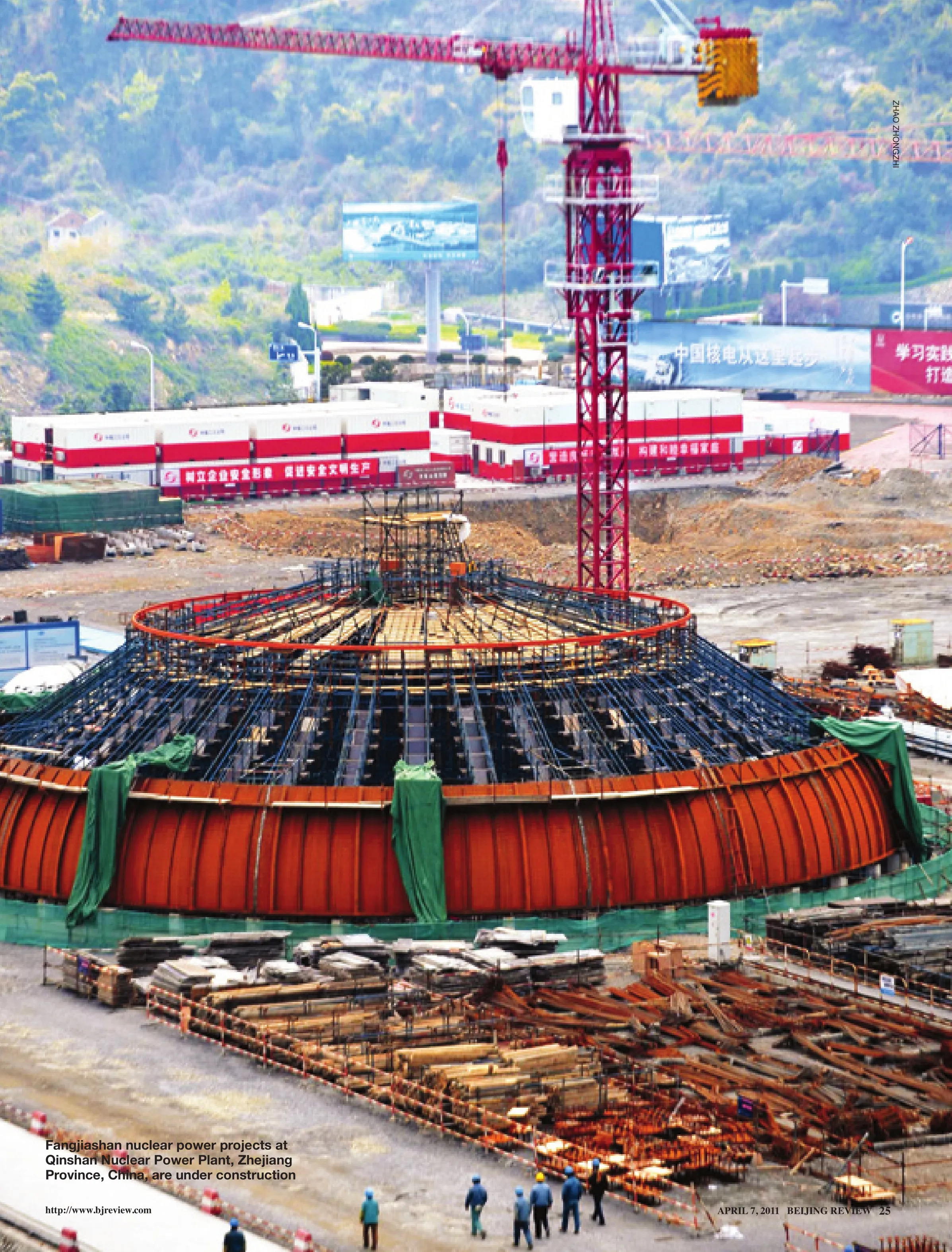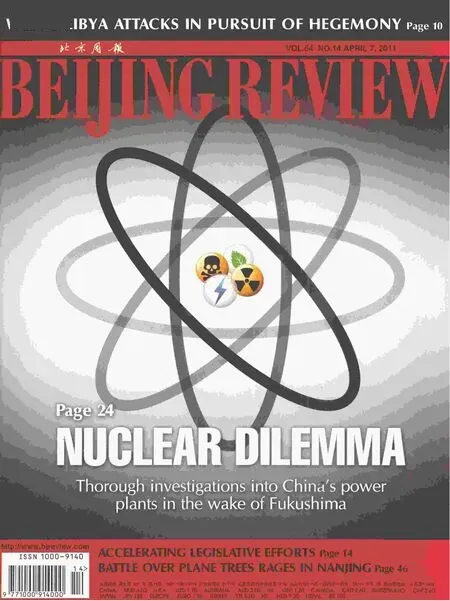RETHINKING NUCLEAR POWER SAFETY
By LAN XINZHEN
RETHINKING NUCLEAR POWER SAFETY
By LAN XINZHEN
The Fukushima nuclear accident sounds alarm bells in China’s nuclear power industry
In the wake of the Fukushima nuclear accident caused by the earthquake and tsunami in Japan, the safety of nuclear power plants and the development of nuclear power have raised concerns, especially in China, which has prioritized nuclear industry to ensure power supply for its booming development.
On March 16, the Chinese Government suspended the approval process for future nuclear power projects. The State Council’s suspension of nuclear power projects to check for dangers or inadequacies in the plants in operation or under construction came just in time, said Yu Zhuoping, consultant for the Chinese Nuclear Society (CNS) and member of the National Nuclear Emergency Coordination Committee.
“Of the nuclear facilities in operation, we should check whether procedures are sound, whether the operation rules are strictly obeyed, whether the management of nuclear power generation sets is powerful enough, and whether the nuclear power supervisory authority is fully performing its duties,” Yu said.

Pan Ziqiang, Director of the Science and Technology Committee of the China National Nuclear Corp. and member of the CNS, agreed with Yu. Of the nuclear power plants in construction, both of them said a safety assessment of the highest standards should be carried out. Hidden dangers must be eliminated and if any plant isn’t in line with safety standards, the construction should be stopped immediately.
Yu said the Fukushima accident would make China elevate the anti-earthquake and anti-tsunami levels of nuclear power plants, but detailed standards will be decided by the National Nuclear Safety Administration. He estimated approval of new nuclear power projects may be resumed after the new standards are released.
But China will not completely put a halt to its nuclear power industry simply out of fear for future catastrophes, said Yu.
Comparing standards
For now, Chinese experts are most concerned with the reasons behind the disaster at the Fukushima Daiichi nuclear power plant. Developing a clearer picture of the problem will allow China to develop preventative measures at its own nuclear power facilities.
Yu said design faws were the chief culprit of the explosion at the Japanese nuclear power plant. Since Japan is frequently hit by earthquakes, the Fukushima designers did incorporate earthquake-resistant factors into the plant’s blueprints. But the recent disaster was more than what Japanese planners had anticipated—damage from the 9.0-magnitude earthquake was minimal. It was the quake-caused tsunami that caused the external auxiliary cooling system to malfunction and eventually fail together.
Improving this technology wouldn’t be too difficult and if tsunami factors were taken into consideration when designing the nuclear power plant, the auxiliary equipment of Fukushima Daiichi nuclear power plant wouldn’t have failed, said Yu.
“The reactor core withstood the tests of the earthquake. The main problem was caused by underestimating the effects of a hit from a tsunami,” said Pan.
Questions have also been raised about


Fukushima plant’s age and how this could have contributed to the nuclear disaster, but Yu thinks otherwise.
“The Fukushima Daiichi nuclear power plant was put into operation in 1971, but we cannot say it is serving beyond its operational lifespan. A more exact conclusion is that it is within the later or last period of its service,” he said.
Nuclear power plants all over the world need to be upgraded and tested each year to ensure effcient power output and safety. “Japan is a big and strong country in terms of nuclear power, and the condition of Fukushima Daiichi nuclear power plant must have been confrmed by the supervising authority to be allowed to extend operation for 20 years,” Yu said.
Comparatively, nuclear power plants in operation or under construction in China do not face the same problems as the Fukushima plant, Yu said.
In China, the threshold for nuclear power plant construction is higher than the world average; earthquake-resistant and floodresistant standards are higher as well. Moreover, boiling water reactor technologies used by the Fukushima Daiichi plant aren’t in use—Chinese nuclear power plants use pressurized water reactor technologies. And all completed nuclear power plants use technologies between the second and third generations with automatic cooling systems more advanced than the second generation technologies used in the Fukushima plant. Nuclear power plants under construction use third-generation technology, with better safety capabilities.
Pan said China’s nuclear industry began in the 1960s and safety issues have always been a priority. The frst provision related to industrial safety in China issued by the State Council is about nuclear radiation and China has established several administrations and institutions for radiation safety. After developing nuclear power, the country set up the National Nuclear Safety Administration.
China’s practice
“In China, supervision of nuclear power safety is stricter than any other industries,”said Yu, who used to be a senior operator at a frst-generation nuclear power plant.
China has a complete set of safety guarantee mechanisms for nuclear power plants, including design, construction, management and operation rules and requirements, equipment maintenance, personnel training, regular tests and radiation protection, Yu said.
China is prudent in selecting the sites for its nuclear power plants, taking the economy, technology, environment and safety into full consideration. With these principles, Chinese nuclear power plants are often located in comparatively remote places in coastal areas, at least 50 km away from large or mediumsized cities. Nuclear power plants are not built within thousands of meters of active fault zones. Within 100 km of sea area and 50 km of land area around the nuclear power plant there shouldn’t have been in history 6.0-magnitude or above earthquakes. Designated areas also should not have experienced 6.0-magnitude or above earthquakes in its geological history within 600 years.
When selecting sites for nuclear power plants, China also considers the influence of excessive radiation on the public and environment should a radiation leak occur. Nuclear power plants are also located in areas that are easy to isolate, in the event of a natural or contrived incident.
Yu said when selecting sites, the maximum level of underground water, the maximum magnitude of earthquakes, the most serious typhoons, thunderbolt strikes, serious mud-rock flows and particularly fight routes should all be considered.
According to the China National Nuclear Corp., designing, construction and operation of Chinese nuclear power plants are all within the principles of multilevel protection.
Current designs provide four protective screens between the nuclear fuels and outside air. The frst is the fuel pellets, with most of the fission products and gas products kept within the pellet. The second is fuel cladding, which is strong enough and will not react with water under high temperature. The third is pressure pipelines and a coolant system, which seals up fuel rods to prevent radioactive substance from leaking to the reactor building. The fourth is reactor containment shield, which can prevent radioactive substances from entering the environment.
Chinese nuclear power plants also have an engineered external safety system, which is divided into three parts. The frst is an isolation system, which isolates the reactor building. The second is an injection system, which can inject water into the reactor core when the reactor loses coolant. The inject system is programmed to automatically pour water under certain pressure if there’s no electric current or manual operation. The third is an emergency cooler and spray system to cool the building and lower the pressure in the building.
Pan said all safety systems in Chinese nuclear power plants use independent equipment and redundant deployment.
Lessons to be learned
Already, Chinese nuclear experts are pouring over the Fukushima nuclear accident, hoping to draw lessons from the disaster.
Before Fukushima, there were two signifcant nuclear accidents in the world: Three Mile Island of the United States in March 1979 and Chernobyl of the former Soviet Union in April 1986.
Pan said after the Three Mile Island accident, the nuclear science circle drew several lessons and made appropriate changes to the nuclear power industry. After the Chernobyl accident, the world learned even more about developing a safer nuclear power culture.
The Chinese nuclear power industry was greatly enhanced after drawing lessons from the Three Mile Island accident, and has improved its technologies to the current level—between second and third generations.
“So far, there hasn’t been a single instance ever of death or sickness caused by radiation in China, and the safety record of China’s nuclear power industry is sound,” Pan said.
But from the Fukushima accident, Pan said, Chinese nuclear power industry should develop a tsunami-resistant strategy. Most Chinese nuclear power plants are in coastal areas with sea walls built around them, which can only resist the waves to a certain breaking point and if a serious tsunami were to hit, the walls would be of little help.
Meanwhile, to balance the relationship of developing nuclear power to cope with the energy crisis and eliminate public worries, Yu said, the government should further improve the safety standards and management level of the industry. The Chinese nuclear power industry faces a bright future, because only nuclear power can replace thermal power on a large scale and reduce emissions of greenhouse gases.
Yu also said people don’t need to fear nuclear radiation, using himself as an example. He has been exposed to nuclear radiation for more than 30 years and hasn’t fallen ill. In the 1960s and 70s, Yu was even exposed to excessive nuclear radiation several times and only had to take prescribed medicine to rid his body of any radiation.
And as for media reports that say 70 percent of the Fukushima 50 heroes who remained on site will die within two weeks, Yu said this is impossible and such reports are mere assumptions.

